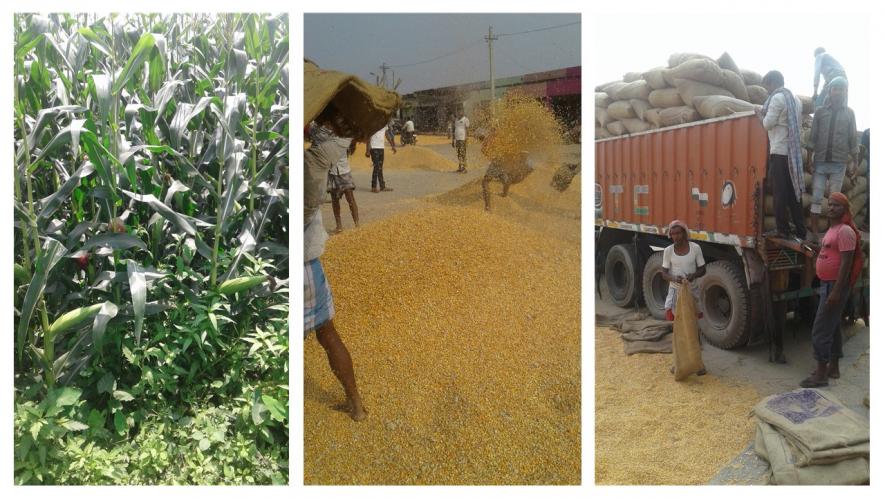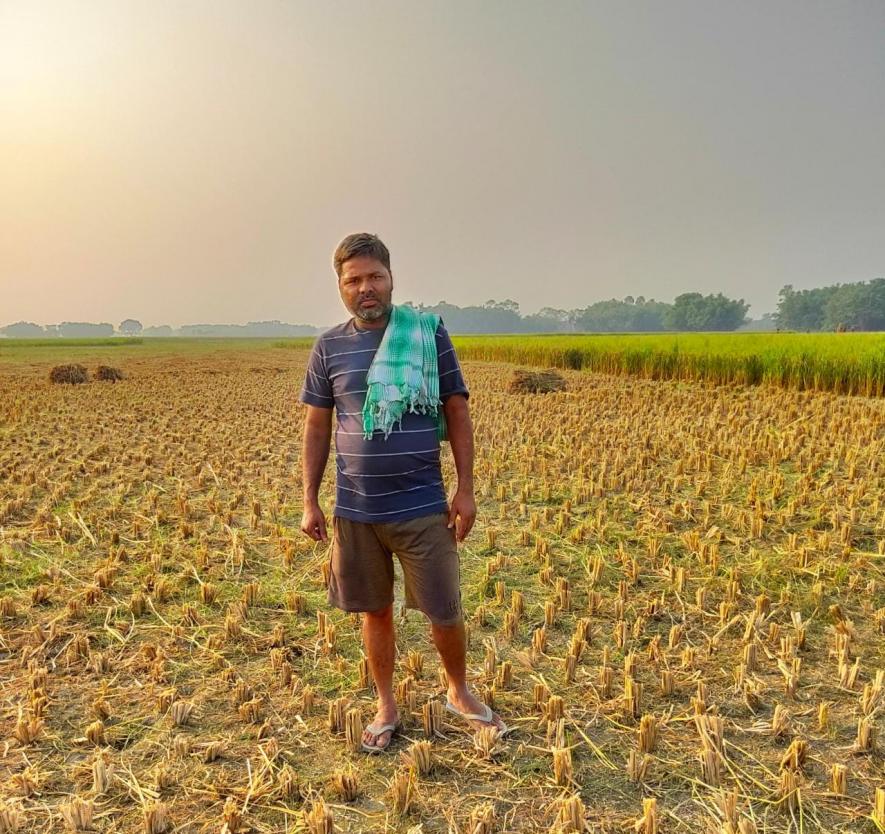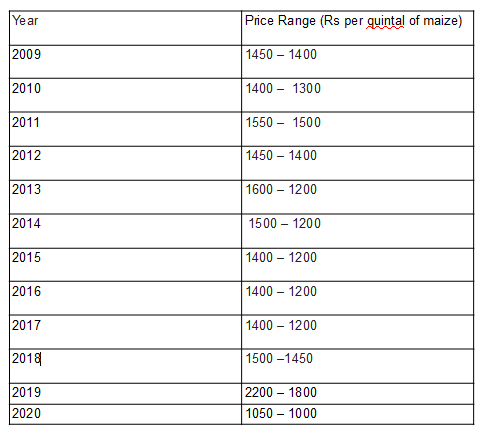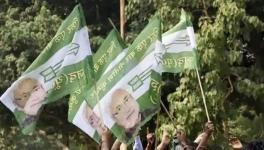Bihar Elections: Maize Farmers from Koshi-Seemanchal get Less than Output Cost, No MSP

Murliganj/Bihariganj: “Labh ki baat chhodiye, makka paida karne ka lagat bhi nahi nikla hai iss saal, bhari nukshan hua hai, kaya karein. Sarkar kewal dhol bajata hai ke kisaan ko MSP mil raha hai; kisaan ka income badha hai sab jhooth hai (Forget making a profit, we do not even make enough from growing maize to break even. We have suffered heavy losses and cannot do anything about it. The government keeps saying that farmers are getting MSP for their crop, but the idea that farmers incomes’ have grown is a lie),” said Trilok Das, a maize grower from the flood-prone Koshi region in Bihar, which, along with the Seemanchal region, is known as a hub of maize cultivation.
Trilok is one of thousands of maize growing farmers who are suffering due to the lack of government support as they hardly get the Minimum Support Price (MSP) for maize, forcing them to resort to distress sales.

Trilok Das standing in his field And near a stored corn. Photo crefit Mohd Imran Khan
Standing in the empty field where he plans on preparing for cultivation again by mid-November, those like him are helpless and left with no other option but to try again. Uncertainty is a constant here.
Unlike last year when he and others made a decent profit by selling their corn due to exceptionally high rates, being forced to go in for a distress sale this year resulted in a heavy loss. “I sold my corn to local traders at between Rs 900 and Rs 1000 per quintal this time, as against Rs 1,800 to Rs 2,000 the last time,” he said. The Centre has fixed an MSP of Rs 1,760 per quintal of maize.
Trilok, a resident of Rajni village in Murliganj block, which falls under the Bihariganj assembly constituency in Madhepura district, said there was a bumper harvest of corn his summer despite the fact that untimely heavy rains in April damaged standing maize crop in the field. “I was hopeful of getting a good return like in 2019. However, I was proved wrong. The lockdown resulted in a price crash after demand was hit. All of this badly affected farmers like me,” he added.
Nearly 40 out of 78 assembly constituencies in the Koshi and Seemanchal belt comprising Madhepura, Saharsa, Supaul, Katihar, Kishanganj, Purnea and Araria will go to polls in the third and final phase of the assembly elections on November 7.
However, low maize prices and no MSP is not an issue in an ongoing election campaign slated to end on November 5. The crop, which is a lifeline for farmers in the region, does not find mention in election manifestos, including those of the BJP, JD(U) and the RJD.
Trilok said that the low prices in May and June resulted in a loss of Rs one lakh to him (including the cost of production and his own labour). “I grow maize in ten acres of land. The cost of production (seeds, fertilisers, insecticides, labour charge) is nearly Rs 15,000 per acre but I got less than that after selling my produce,” he said.
He said that if he – a relatively well-off farmer – was suffering, he could not imagine the plight of small and marginal farmers. “I had a good yield of about 25 to 30 quintals per acre as I primarily sow hybrid seeds and see to irrigation and labour. But poor farmers cannot do the same because it requires more money,” he said.
Shambhu Kumar, a small maize growing farmer from the same village, is in the same boat – he got less than the cost of production and had no direct market support. “Taking advantage of the lockdown traders offered me half the price I got last year. With no other option, I was forced to sell the corn that I produce in three bighas of land,” he said.
Shambhu said that the distress sale caused a big loss. “I expected to make some money to get by but I got half of what I got last year. I sold my corn at Rs 1,050 per quintal last week after having waited for over three months in the hope that prices will go up. Maize is widely seen here as a cash crop,” said Shambhu, the bread-winner in a family of five.
He told NewsClick that maize growing farmers were forced to migrate as workers in factories due to the low income from agriculture. “The double-engine government of Prime Minister Narendra Modi and Bihar Chief Minister Nitish Kumar are responsible for this. The Modi government declared MSP for maize on paper and the Nitish government refused to provide it. Farmers have been left in the lurch,” he said. He added that the government continues to ignore farmers, leaving them angry. “I have not come across a single farmer here who is happy with the government,” he said.
Bijender, a resident of Gangapur village, said he suffered a loss of Rs 70,000 this year. “The rate I got was half of last year. I sold 150 quintals of corn from eight bighas of land at Rs 1,000 per quintal. Let alone profit, we could not make up the production cost,” he said.

Bijendar Yadav. Photo crefit Mohd Imran Khan
Rajendar Mandal of Dighi village said farmers have been cheated by the government. “The Modi government’s promises of doubling our income is far into the future. The Centre has fixed MSP and the state government are not giving it to us. Why claim then that farmers have got MSP?” he asked.
“The government should help us by procuring maize at MSP in the same way that it does for paddy and wheat farmers. We hardly get any support but are exploited by local traders in the absence of government support,” he said.
Sanjeev Kumar, who owns five bighas of land in Tulsia village, said uncertainty continues to shroud prices of corn. He said that it was between Rs 1,800 and Rs 2,200 last year and had come down to between Rs 900 and Rs 1,050 this year. “A large number of farmers increased corn cultivation in view of the high rate last year. However, they got half the rate his year; it is a big setback,” he said. Tulasia village under Bihariganj block said
Rampravesh Kumar, a young farmer, said poor prices for corn discourages farmers from growing more. Farmers have shifted their focus from jute, paddy and wheat to maize over a decade ago.
A resident of Lachmipur village, Rampravesh said government and private companies should set up processing units to use corn as poultry and cattle feed. “It will result in good prices for local maize farmers,” he opined.
Sandeep Yadav, president of Koshi Nav Nirman Manch(KNNM), said it has been demanding MSP for maize farmers like for paddy and wheat growers. “Maize farmers have staged multiple protests but the government ignored it. Nothing has happened in the six months since we made our demands to CM Nitish Kumar. It shows the government’s sensitivity towards farmers,” he said.

KNNM president Sandip
KNNM convenor Mahendar Yadav had filed a PIL in the Patna High Court in June this year, seeking a direction to the state government to procure maize at MSP from farmers. The court refused to issue any direction in this matter.
The petitioner said that the state government opposed his petition on the grounds that procurement of a particular crop is a policy matter and since FCI godowns are likely to be full of other food grain, any decision to fix MSP would be contrary to public interest and against the policy.
Manch leaders recalled that over six years ago, Prime Minister Narendra Modi had promised adequate MSP for maize crop during his election campaign ahead of the 2014 Lok Sabha Elections.
Unlike paddy and wheat, which the state government procures directly from farmers through Primary Agriculture Credit Societies (PACS), it does not buy maize. Hence, there is no minimum support price (MSP) for maize farmers in Bihar. They are deprived of MSP and are exploited by traders as a result, he said.
According to officials from the agriculture department in the state, nearly 65% of the total maize from Bihar is grown in the Seemanchal and Koshi regions alone. Maize is mainly grown in the four Seemanchal districts of Purnea, Kishanganj, Araria, Katihar and in the neighboring districts of Madhepura, Saharsa, Supaul and Khagaria, areas that form the Koshi region.
As per government data, maize is grown in about 1,40,000 hectares in the Seemanchal region and over about 90,000 hectares in the Koshi region.
More than 17 lakh MT of maize is grown annually in Seemanchal and Koshi. Of this, more than 14 lakh MT is purchased by traders and MNCs and sent outside the area, while around three lakh MT is consumed locally, according to data till 2019.
A decade ago, maize was grown on a small scale. As high yields, high demand and a good profit got the crop its pila sona (yellow gold) tag, more and more farmers took to cultivating maize. Village after village in the two regions switched from paddy and wheat to maize.
According to agriculture department officials, Bihar has a high maize productivity of 3,904 kg/ha, more than the national average of 2,889kg/ha. The state has witnessed a sizable growth in maize production over the past decade.
Bihar is India’s third largest producer of maize. The state produced 1.36 million tons of the crop in 2005-06. This increased to 3.85 million tons in 2016-17, as the high-yielding maize of Rabi season has been replacing the winter crops of wheat and paddy in the state.
Below is a list of maize prices over the last twelve years:

Get the latest reports & analysis with people's perspective on Protests, movements & deep analytical videos, discussions of the current affairs in your Telegram app. Subscribe to NewsClick's Telegram channel & get Real-Time updates on stories, as they get published on our website.
























